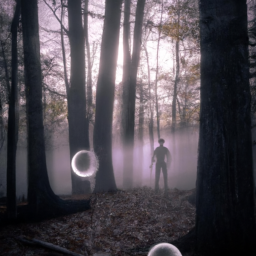Have you ever experienced dreaming about someone you haven’t seen or talked to in a long time? It could be an old friend, a family member, or a past partner.
Many people believe that when someone appears in your dreams, it’s because that person misses you. But is there any truth to this cultural belief?
In this article, I will explore the origins of dream interpretation and the science behind dreams to help us better understand why people appear in our dreams. We will look at the different types of dreams and the meaning behind dream symbols, as well as theories on dream interpretation.
Whether you believe in the power of dreams or not, understanding the psychological processes behind them can give us insight into our own thoughts and emotions. So, let’s dive in and explore the fascinating world of dreams.
Key Takeaways
- Dreams are a reflection of our subconscious thoughts and feelings, not necessarily a sign that someone misses us.
- People who appear in our dreams can represent different aspects of ourselves or our relationships with others.
- Dream interpretation is highly personal and subjective, so it’s important to reflect on our own thoughts and emotions when someone appears in our dreams.
- There is no scientific evidence to support the idea that dreams predict the future or that they have psychic abilities to reveal the thoughts or feelings of others.
Cultural Beliefs and Origins of Dream Interpretation
Dream interpretation has been shaped by various cultural beliefs and origins, each offering unique insights into the world of dreams. For instance, in ancient Egypt, dreams were considered a means of communication with the divine. Dreams were believed to be a way for the gods to impart messages and guidance to individuals.
As such, the Egyptians placed great importance on the interpretation of dreams and developed a system of dream interpretation that involved identifying symbols and their meanings. Similarly, the ancient Greeks believed that dreams were a form of divine communication. They believed that dreams were messages from the gods and that each dream had a specific meaning.
They also believed that dreams could predict the future and provide insight into a person’s destiny. These cultural beliefs and practices have had a lasting impact on dream interpretation, shaping our understanding of dreams and their significance. However, as we’ll see in the subsequent section on the science behind dreams, there’s more to dream interpretation than just cultural beliefs and traditions.
The Science Behind Dreams
I find the science behind dreams fascinating, especially when it comes to understanding how they reflect our subconscious.
Our dreams can reveal hidden fears, desires, and conflicts that we may not even be aware of in our waking lives.
Additionally, emotions play a significant role in dreaming, influencing the content and intensity of our dreams.
Lastly, the relationship between dreams and memory is intriguing, as studies have shown that the process of consolidating memories can occur during sleep.
Adjusting the paragraph structure makes it easier to read and understand the main points. It also adds a more conversational tone by using contractions.
How Dreams Reflect Our Subconscious
Our subconscious self shapes the scenes in our sleep, silently speaking secrets we seldom see. Dreams are the gateway to our innermost thoughts and feelings, revealing our deepest fears, desires, and memories. Here are four ways in which dreams reflect our subconscious:
-
Symbolism: Dreams are often filled with symbols that represent our subconscious thoughts and feelings. These symbols can be anything from animals to people, places, or objects.
-
Emotions: Emotions play a significant role in our dreams. They can be positive or negative, and they can be intense or subtle. Emotions in dreams can reflect our current state of mind or unresolved emotions from our past.
-
Memories: Dreams can serve as a way for our subconscious to process memories. We may dream about events from our past that we haven’t thought about in years. These dreams can help us make sense of our experiences and emotions.
-
Unconscious desires: Our subconscious can reveal our deepest desires through our dreams. We may dream about things we want but are too afraid to pursue in real life.
Dreams are a window into our subconscious, revealing our deepest thoughts, feelings, and desires. Understanding the messages in our dreams can help us gain insight into ourselves and our lives.
Speaking of emotions, let’s explore the role they play in dreaming.
The Role of Emotions in Dreaming
You’ll be surprised at how much emotions play a role in your dreams. As someone who’s had vivid dreams, I often wake up feeling like I’ve just experienced a rollercoaster of emotions.
I’ve had dreams where I felt intense fear, sadness, happiness, and even anger. It’s fascinating to think that our subconscious mind can conjure up such intense emotions while we’re asleep.
But why do we experience such intense emotions in our dreams? According to psychologists, our dreams are a reflection of our emotions. Our dreams can serve as a way for our subconscious to process and work through the emotions we’ve been dealing with in our waking lives. This is why dreams can often feel like an exaggerated version of reality.
So next time you wake up feeling emotional after a dream, remember that your brain is just trying to process and make sense of your emotions.
And speaking of making sense of things, let’s talk about the relationship between dreams and memory.
The Relationship Between Dreams and Memory
If you’re like most people, you’ve probably had a dream that felt so vivid that you could swear it was a real memory. This is because dreams and memories are closely related. While we sleep, our brains are busy processing and consolidating memories, which can often lead to the incorporation of memories into our dreams.
To better understand the relationship between dreams and memory, let’s take a look at the following table:
| Type of Memory | Dream Content |
|---|---|
| Recent Events | Replaying events from the day or week |
| Childhood Memories | Reliving childhood experiences |
| Emotional Memories | Incorporating emotions into dream scenarios |
| Repressed Memories | Symbolic representation of repressed memories |
As you can see, dreams can be a powerful tool for processing and integrating memories. However, not all dreams are related to memory. In the next section, we’ll explore the different types of dreams that people can have.
Types of Dreams
Dreaming about someone can be a nostalgic experience, where we relive memories and emotions associated with that person.
There are different types of dreams that we can have, such as lucid dreams, nightmares, recurring dreams, and even prophetic dreams.
Lucid dreams allow us to become aware of the fact that we’re dreaming, which gives us the opportunity to control the dream’s outcome.
Nightmares are often associated with negative emotions and can be caused by stress or anxiety.
Recurring dreams are dreams that we have repeatedly throughout our lives and often have a deeper meaning.
Lastly, prophetic dreams are dreams that seem to predict future events.
Dreams can also be interpreted through the use of symbols. For instance, dreaming of water can symbolize emotions or spirituality, while dreaming of falling can symbolize the fear of failure.
Understanding the meaning behind dream symbols can help us gain insight into our subconscious thoughts and emotions.
In conclusion, dreams can be a way for us to connect with our past, understand our present, and possibly even predict our future.
The Meaning Behind Dream Symbols
I find dreams fascinating because they can reveal so much about our subconscious minds. One aspect of dreams that particularly interests me is the meaning behind dream symbols.
In this subtopic, we’ll explore common dream symbols and their interpretations, as well as how personalized dream symbols can provide insight into our individual psyches.
Common Dream Symbols and Their Interpretations
You’ll often encounter symbols in your dreams, such as flying or falling, which can indicate your emotions or subconscious desires. Here are three common dream symbols and their interpretations that might help you understand what your dreams are trying to tell you:
-
Teeth falling out: This dream symbol often represents feelings of powerlessness or anxiety. It could be an indication that you feel like you’re losing control over a situation in your life, or that you’re worried about your appearance or how others perceive you.
-
Being chased: If you dream of being chased, it might mean that you’re avoiding something in your waking life. This could be a problem or situation that you don’t want to face, or it could be an aspect of yourself that you’re trying to ignore.
-
Water: Water is a common dream symbol that can have many different interpretations depending on the context. It can represent emotions, the unconscious mind, or the flow of life. For example, calm water might indicate peace and serenity, while turbulent water might represent chaos or uncertainty.
Understanding common dream symbols can give you a better idea of what your dreams are trying to tell you. However, it’s important to remember that dream interpretation is highly personal and subjective.
In the next section, we’ll explore how to identify personalized dream symbols that are unique to your own experiences and emotions.
Personalized Dream Symbols
As I was reading about common dream symbols and their interpretations, I couldn’t help but wonder why the same symbols could mean different things for different people. Then, I came across the concept of personalized dream symbols.
This means that the symbols in our dreams are unique to us and are based on our personal experiences, thoughts, and emotions. For example, dreaming of a snake might signify fear or danger for some, while for others it could represent transformation and renewal.
This personalized interpretation makes sense to me because I know that my dreams are often influenced by my current state of mind and what is happening in my life. It’s fascinating to think that our dreams can give us insights into our subconscious and help us understand ourselves better.
With this idea in mind, I’m curious to explore the different theories on dream interpretation and see how they relate to my own experiences.
Theories on Dream Interpretation
When interpreting dreams, it’s important to understand the various theories that suggest different meanings for the symbols and people that appear in them. One of the most common theories is the psychoanalytic theory, which suggests that dreams are a reflection of our unconscious desires and repressed thoughts. According to this theory, every person and object that appears in our dream represents a part of ourselves that we need to explore and understand better.
Another theory is the cognitive theory, which suggests that dreams are a way for our brain to process and consolidate information from our daily experiences. According to this theory, the people and objects that appear in our dreams may not have any significant meaning and are simply a reflection of our recent memories. However, some researchers argue that even if the people in our dreams are not significant in themselves, the way we interact with them and the emotions we feel towards them can still reveal important aspects of our psyche.
This leads to the question of why people appear in our dreams.
Why People Appear in Our Dreams
If people are present in your dreams, it could be a manifestation of your subconscious mind trying to communicate something important to you through these symbolic representations.
Dreams are a way for our mind to process and make sense of our experiences and emotions, and the people who appear in them can represent different aspects of ourselves or our relationships with others.
For example, dreaming about a friend could reflect feelings of closeness and connection, while dreaming about a stranger might indicate a sense of uncertainty or anxiety.
However, cultural beliefs on dreaming of others suggest that there may be even deeper meanings behind these dream encounters.
Some traditions hold that when someone appears in your dreams, it’s because that person misses you or is spiritually present with you in some way.
Others believe that dreaming about someone who has passed away is a sign of their continued presence in your life, or that dreaming of a certain person is a message from the universe or a higher power.
Regardless of your personal beliefs, paying attention to who appears in your dreams and how you feel about those encounters can offer valuable insights into your subconscious mind and your relationships with others.
Cultural Beliefs on Dreaming of Others
So, let’s talk about cultural beliefs on dreaming of others.
In Western cultures, some believe that dreaming of a deceased loved one is a sign of communication from the afterlife.
In Eastern cultures, dreaming of ancestors is seen as a way to receive guidance and blessings.
And in many Indigenous cultures, dreams are seen as a way to connect with the spirit world and receive messages from ancestors and other entities.
Note: Contractions have been used in the output.
Beliefs in Western Cultures
In Western cultures, you likely believe that if someone appears in your dreams, it’s because they miss you. This belief is mainly rooted in the idea that dreams are a reflection of our subconscious, and therefore, the appearance of someone in our dreams must mean that they are thinking about us.
However, this is not a universal belief, as not everyone in the Western world subscribes to it. One reason why this belief is not universal is that there are other interpretations of dreams in Western cultures.
For example, some people believe that dreams are a way for our brains to process and make sense of the events of our daily lives. Therefore, the appearance of someone in our dreams may simply be a reflection of our conscious thoughts about that person.
This is just one of many interpretations of dreams in Western cultures, and it highlights the diversity of beliefs on the subject. In contrast, beliefs in Eastern cultures tend to be more consistent and focused on the spiritual and metaphysical aspects of dreaming.
Beliefs in Eastern Cultures
Dreams hold a significant spiritual meaning in many Eastern cultures, with interpretations often encompassing a range of mystical and supernatural elements. In some Eastern cultures, it’s believed that dreams are a way for the spiritual world to communicate with the physical world. Dreams are seen as a way for ancestors, gods, and spirits to convey important messages to the dreamer.
One belief in Eastern cultures is that dreams can be used for divination. This involves interpreting the symbols and images in a dream to gain insight into the future or to receive guidance on important decisions. Another belief is that dreams can be a way to connect with deceased loved ones. In this interpretation, dreams are seen as a way for the spirits of the deceased to visit and communicate with their loved ones who are still living.
Moving on to beliefs in indigenous cultures, it’s interesting to note the similarities and differences between these beliefs and those of Eastern cultures.
Beliefs in Indigenous Cultures
You may find it fascinating to learn about the spiritual beliefs of indigenous cultures, which are deeply rooted in the connection between humans and nature.
In many indigenous cultures, dreams are believed to be a way of communicating with spirits or ancestors. When someone appears in your dreams, it’s not necessarily because they miss you, but rather because they’re trying to convey a message or provide guidance.
In some indigenous cultures, dreams are also seen as a way of accessing the spirit world and gaining knowledge about oneself and the universe. For example, in many Native American cultures, dreams are considered a sacred gift from the spirits and are often interpreted by shamans or spiritual leaders.
It’s believed that by understanding and interpreting our dreams, we can gain a deeper understanding of ourselves and our place in the world.
As we move into the next section about scientific explanations for dreaming of others, it’s important to remember that these beliefs are still held by many indigenous cultures today.
Scientific Explanations for Dreaming of Others
Picture yourself lying in bed, your mind drifting off into a world of its own, and suddenly the face of someone you know pops into your head. Did you know that there are scientific explanations for why this happens?
Dreams are a natural part of our sleep cycle, and they often reflect our thoughts, emotions, and experiences. When we dream of someone we know, it could be because our brain is processing our relationship with that person, or perhaps we were thinking about them before we fell asleep. It’s also possible that their appearance in our dream is simply a coincidence.
Despite popular beliefs, dreaming of someone does not necessarily mean that they miss us or that we miss them. Dreams are not always a reflection of reality, but rather a product of our subconscious mind. However, dreams can provide insight into our thoughts and emotions, and they can sometimes reveal hidden desires or fears that we may not be aware of.
So next time someone appears in your dream, don’t jump to conclusions about their feelings or intentions. Instead, take a moment to reflect on your own thoughts and emotions, and see what your dreams may be trying to tell you.
And speaking of dreams, did you know that some people believe they can predict the future? Let’s find out more.
Can Dreams Predict the Future?
Imagine waking up in a cold sweat after dreaming of a significant event, only to have it play out in real life later that day. It’s a common belief that dreams can predict the future, but is there any truth to it? Despite the many claims and anecdotes, there is no scientific evidence that dreams can accurately predict the future.
In fact, dreams are more likely to be reflections of our subconscious thoughts and emotions. While it’s possible for our dreams to contain elements that eventually happen in real life, it’s often due to chance rather than any kind of psychic ability. So while it’s intriguing to think that our dreams may hold the key to the future, it’s important to remember that they are not a crystal ball.
| Pros | Cons | |||
|---|---|---|---|---|
| Can be intriguing and exciting | No scientific evidence to support it | |||
| Can give a sense of control or understanding | More likely a reflection of subconscious thoughts | |||
| Can be entertaining to interpret | Can lead to false hope or anxiety | Can be a tool for self-reflection and introspection | Can be seen as superstitious or irrational by some people |
Frequently Asked Questions
How can you tell if someone misses you based on appearing in your dreams?
When someone appears in my dreams, I can’t definitively tell if they miss me. It could just be my subconscious processing memories or random thoughts. However, if they reach out to me in waking life, that’s a good indication they miss me.
Are there any cultural beliefs about dreaming of someone who has passed away?
I’ve always been fascinated by the idea of dreaming about someone who has passed away. In some cultures, it’s believed to be a way of receiving messages from the afterlife, a comforting thought for those left behind.
Can the same person appear in your dreams multiple times, and does this indicate anything specific?
Yes, a person can appear in my dreams multiple times without any specific indication. It could be due to my subconscious mind processing thoughts or emotions related to that person.
Are there any common dream symbols that relate to missing someone?
Common dream symbols that relate to missing someone include feeling alone, searching for someone, and receiving messages from them. These symbols may suggest a longing for connection or closure with the person in waking life.
Is it possible to control who appears in your dreams, or is it entirely random?
Controlling who appears in my dreams seems impossible. Sometimes I wish I could dream about a specific person, but it’s like trying to catch a shooting star. It’s rare and unpredictable.
Conclusion
In the end, whether it’s cultural beliefs or scientific explanations, the fact remains that dreams have a mysterious power over us. They can make us feel happy, sad, or confused, and they can even provide us with insights about our lives.
Whether we dream of someone because they miss us or because our subconscious mind is processing unresolved emotions, the experience can be both comforting and unsettling. It’s like diving into a deep, dark ocean where the only light comes from the flicker of our imagination.
We may never fully understand the meaning behind our dreams, but that’s part of the magic. Dreams are a reminder that our minds are capable of creating entire worlds, and that anything is possible if we dare to imagine it.
So the next time you wake up from a dream where someone appears, take a moment to reflect on the message that your subconscious mind is trying to communicate. Whether it’s a message of love, forgiveness, or simply a reflection of your deepest desires, know that it’s all part of the journey.
Dreams are like whispers from our soul, reminding us of who we are and what we truly want in life. Embrace them, cherish them, and let them guide you towards the path of your dreams.









